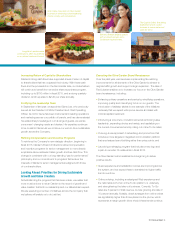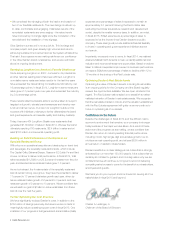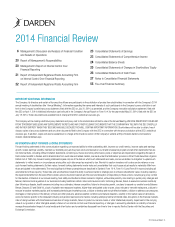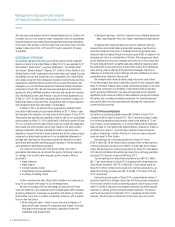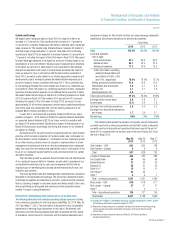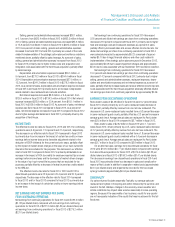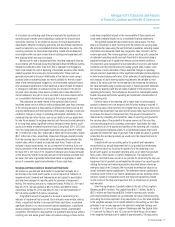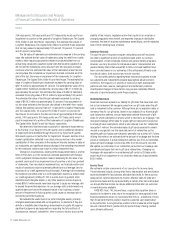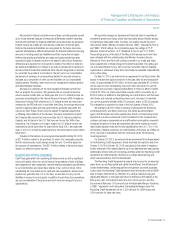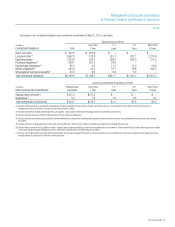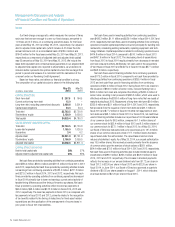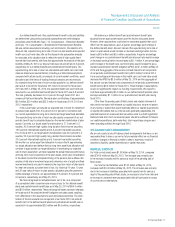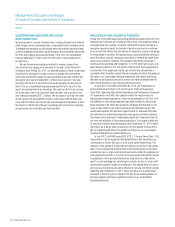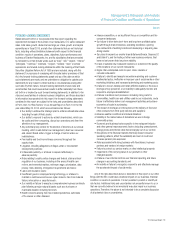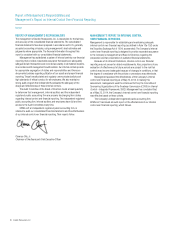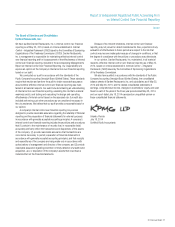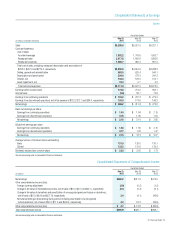Red Lobster 2014 Annual Report Download - page 15
Download and view the complete annual report
Please find page 15 of the 2014 Red Lobster annual report below. You can navigate through the pages in the report by either clicking on the pages listed below, or by using the keyword search tool below to find specific information within the annual report.
Management’s Discussion and Analysis
of Financial Condition and Results of Operations
Darden
2014 Annual Report 13
We provide for federal and state income taxes currently payable as well
as for those deferred because of temporary differences between reporting
income and expenses for financial statement purposes versus tax purposes.
Federal income tax credits are recorded as a reduction of income taxes.
Deferred tax assets and liabilities are recognized for the future tax conse-
quences attributable to differences between the financial statement carrying
amounts of existing assets and liabilities and their respective tax bases.
Deferred tax assets and liabilities are measured using enacted tax rates
expected to apply to taxable income in the years in which those temporary
differences are expected to be recovered or settled. The effect on deferred
tax assets and liabilities of a change in tax rates is recognized in earnings in
the period that includes the enactment date. Interest recognized on reserves
for uncertain tax positions is included in interest, net in our consolidated
statements of earnings. A corresponding liability for accrued interest is
included as a component of other current liabilities on our consolidated
balance sheets. Penalties, when incurred, are recognized in selling, general
and administrative expenses.
We base our estimates on the best available information at the time
that we prepare the provision. We generally file our annual income tax
returns several months after our fiscal year end. For U.S. federal income tax
purposes, we participate in the Internal Revenue Service’s (IRS) Compliance
Assurance Process (CAP) whereby our U.S. federal income tax returns are
reviewed by the IRS both prior to and after their filing. Income tax returns are
subject to audit by state and local governments, generally years after the
returns are filed. These returns could be subject to material adjustments
or differing interpretations of the tax laws. The major jurisdictions in which
the Company files income tax returns include the U.S. federal jurisdiction,
Canada, and all states in the U.S. that have an income tax. With a few
exceptions, the Company is no longer subject to U.S. federal income tax
examinations by tax authorities for years before fiscal 2013, and state and
local, or non-U.S. income tax examinations by tax authorities for years before
fiscal 2010.
Included in the balance of unrecognized tax benefits at May 25, 2014
is $27.4 million related to tax positions for which it is reasonably possible
that the total amounts could change during the next 12 months based on
the outcome of examinations. The $27.4 million relates to items that would
impact our effective income tax rate.
LIQUIDITY AND CAPITAL RESOURCES
Cash flows generated from operating activities provide us with a significant
source of liquidity, which we use to finance the purchases of land, buildings
and equipment for new restaurants, remodel existing restaurants, pay dividends
to our shareholders and repurchase shares of our common stock. Since
substantially all of our sales are for cash and cash equivalents, and accounts
payable are generally due in 5 to 30 days, we are able to carry current
liabilities in excess of current assets. In addition to cash flows from operations,
we use a combination of long-term and short-term borrowings to fund our
capital needs.
We currently manage our business and financial ratios to maintain an
investment grade bond rating, which has historically allowed flexible access
to financing at reasonable costs. Currently, our publicly issued long-term
debt carries “Baa3” (Moody’s Investors Service), “BBB-” (Standard & Poor’s)
and “BBB-” (Fitch) ratings. Our commercial paper has ratings of “P-3”
(Moody’s Investors Service), “A-3” (Standard & Poor’s) and “F-3” (Fitch).
These ratings are as of the date of the filing of this annual report and have
been obtained with the understanding that Moody’s Investors Service,
Standard & Poor’s and Fitch will continue to monitor our credit and make
future adjustments to these ratings to the extent warranted. The ratings are
not a recommendation to buy, sell or hold our securities, may be changed,
superseded or withdrawn at any time and should be evaluated independently
of any other rating.
On May 15, 2014, we entered into an agreement to sell Red Lobster. We
expect to receive net cash proceeds from the sale, after tax and transaction
costs, of approximately $1.60 billion, of which approximately $1.00 billion
will be used to retire outstanding long-term debt. We expect to use the
remaining net proceeds of approximately $500.0 million to $600.0 million
in fiscal 2015 for our share repurchase program which is currently up to
$700.0 million. In addition to strengthening our credit metrics, with the lower
debt levels and reduced outstanding share count, we expect to maintain
our current quarterly dividend of $0.55 cents per share, or $2.20 annually.
The transaction is expected to close in the first quarter of fiscal 2015.
We maintain a $750.0 million revolving Credit Agreement (Revolving
Credit Agreement), with Bank of America, N.A. (BOA) as administrative
agent, and the lenders and other agents party thereto. The Revolving Credit
Agreement is a senior unsecured credit commitment to the Company and
contains customary representations and affirmative and negative covenants
(including limitations on liens and subsidiary debt and a maximum consoli-
dated lease adjusted total debt to total capitalization ratio of 0.75 to 1.00)
and events of default customary for credit facilities of this type. As of May 25,
2014, we were in compliance with the covenants under the Revolving
Credit Agreement.
On October 24, 2013, we entered into an amendment (First Amendment)
to the Revolving Credit Agreement, which extended the maturity date from
October 3, 2016 to October 24, 2018, and gives us the option to request a
further extension of the maturity date for up to two additional one-year periods.
Additionally, interest rates on borrowings and fees under the Revolving Credit
Agreement are determined by reference to a ratings-based pricing grid,
which was amended by the First Amendment.
The Revolving Credit Agreement proceeds may be used for commercial
paper back-up, working capital and capital expenditures, the refinancing of
certain indebtedness, certain acquisitions and general corporate purposes.
Loans under the Revolving Credit Agreement bear interest at a rate of LIBOR
plus a margin determined by reference to a ratings-based pricing grid
(Applicable Margin), or the base rate (which is defined as the highest of the
BOA prime rate, the Federal Funds rate plus 0.500 percent, and the
Eurocurrency Rate plus 1.00 percent) plus the Applicable Margin. Assuming
a “BBB-” equivalent credit rating level, the Applicable Margin under the
Revolving Credit Agreement will be 1.300 percent for LIBOR loans and
0.300 percent for base rate loans.


